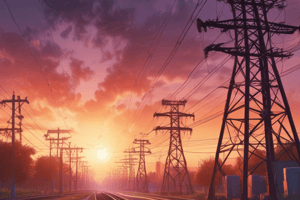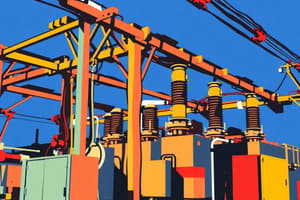Podcast
Questions and Answers
What is the main purpose of an electrical distribution system?
What is the main purpose of an electrical distribution system?
To efficiently and safely deliver electricity to end-users while ensuring reliability and stability of the system.
What are the components of an electrical distribution system?
What are the components of an electrical distribution system?
Power lines, transformers, circuit breakers, fuses, and meters.
Define an electrical distribution system.
Define an electrical distribution system.
A network of electrical components used to supply power to buildings, homes, and industries.
What is the role of transformers in an electrical distribution system?
What is the role of transformers in an electrical distribution system?
What does the distribution system consist of?
What does the distribution system consist of?
Where does the distribution system receive high-voltage electricity from?
Where does the distribution system receive high-voltage electricity from?
What makes the underground system more expensive compared to the overhead system?
What makes the underground system more expensive compared to the overhead system?
Which system, overhead or underground, is more flexible?
Which system, overhead or underground, is more flexible?
Why are faults in underground systems considered rare?
Why are faults in underground systems considered rare?
What contributes to the better appearance of underground systems?
What contributes to the better appearance of underground systems?
What is a disadvantage of underground systems when it comes to fault location and repairs?
What is a disadvantage of underground systems when it comes to fault location and repairs?
How does the current carrying capacity and voltage drop compare between overhead and underground systems?
How does the current carrying capacity and voltage drop compare between overhead and underground systems?
What is a 2-wire DC system used for in distribution?
What is a 2-wire DC system used for in distribution?
Explain the difference between the outgoing and return wires in a 2-wire DC system.
Explain the difference between the outgoing and return wires in a 2-wire DC system.
What is the main advantage of a 3-wire DC system over a 2-wire system?
What is the main advantage of a 3-wire DC system over a 2-wire system?
Why are lamps and heating circuits connected between either outer and the neutral in a 3-wire DC system?
Why are lamps and heating circuits connected between either outer and the neutral in a 3-wire DC system?
Name two methods of obtaining a 3-wire DC system.
Name two methods of obtaining a 3-wire DC system.
Why is the 2-wire DC system never used for transmission purposes?
Why is the 2-wire DC system never used for transmission purposes?
What are the two types of distribution systems based on the nature of current?
What are the two types of distribution systems based on the nature of current?
Why is the overhead system more commonly used for distribution?
Why is the overhead system more commonly used for distribution?
Name the three schemes of connection in a distribution system based on connection.
Name the three schemes of connection in a distribution system based on connection.
What is the main advantage of using alternating current in distribution systems?
What is the main advantage of using alternating current in distribution systems?
In what situations is the underground distribution system typically used?
In what situations is the underground distribution system typically used?
Why is alternating current preferred over direct current in modern distribution systems?
Why is alternating current preferred over direct current in modern distribution systems?
What are the limitations of the radial system connection scheme in a distribution system?
What are the limitations of the radial system connection scheme in a distribution system?
Describe the ring main system connection scheme in a distribution system.
Describe the ring main system connection scheme in a distribution system.
What advantage does the ring main system offer in terms of supply reliability?
What advantage does the ring main system offer in terms of supply reliability?
How does the ring main system prevent voltage fluctuations at consumer's terminals?
How does the ring main system prevent voltage fluctuations at consumer's terminals?
Explain how supply continuity is maintained in the ring main system in case of a fault.
Explain how supply continuity is maintained in the ring main system in case of a fault.
Provide an example scenario where the ring main system ensures continuity of supply in case of a fault.
Provide an example scenario where the ring main system ensures continuity of supply in case of a fault.




